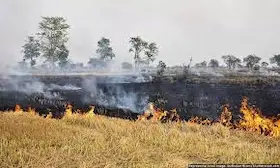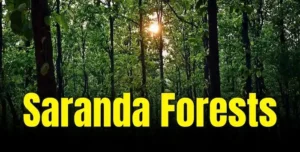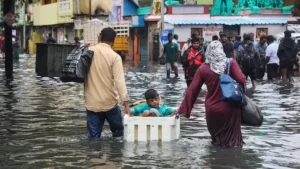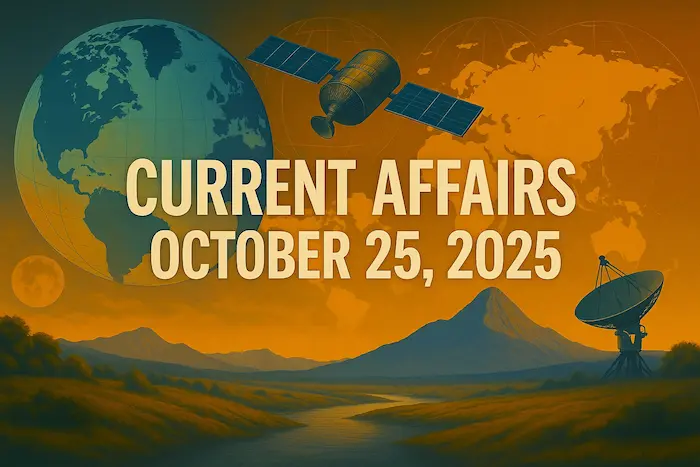1. Stubble Burning in Punjab – Decline in Numbers, Data Gaps Persist – Environment

Why in News?
Satellite-based data (2024) shows a 70% decline in recorded stubble burning incidents in Punjab, dropping from 36,663 (2023) to 10,909 (2024).
However, the total area affected (≈19.17 lakh hectares) remains largely unchanged, raising concerns about data reliability and the effectiveness of policy measures.
What Is Stubble Burning?
Stubble burning refers to the open-air burning of crop residue, especially paddy straw, to clear fields for the next sowing cycle (usually wheat).
Most common in Punjab, Haryana, and Western Uttar Pradesh.
Paddy stubble is difficult to manage due to:
Short window between harvest and next sowing
Lack of economic value for the residue
Environmental & Health Impacts
| Impact | Description |
|---|---|
| Air Pollution | Major contributor to PM2.5 and PM10 levels during winters in Delhi-NCR. |
| Public Health | Causes respiratory illnesses, especially among children and elderly. |
| Climate Impact | Adds to greenhouse gas emissions, including CO₂, CH₄, and N₂O. |
| Soil Health Degradation | Burning organic matter leads to loss of soil fertility. |
Latest Data Highlights (2024)
| Year | Total Fire Incidents | Total Area Affected |
|---|---|---|
| 2023 | 36,663 | ~19.3 lakh hectares |
| 2024 | 10,909 (↓ 70%) | ~19.17 lakh hectares (nearly unchanged) |
Inference: Fewer recorded fires, but same scale of burning → Suggests either larger fires or monitoring gaps.
Data Gaps in Satellite Monitoring
Issues:
Satellites may not detect:
Smaller fires
Nighttime burning
Fires obscured by cloud cover or smoke
Underreporting distorts policymaking, funding allocation, and enforcement strategies.
Needed Improvements:
Higher-resolution satellites
AI-powered monitoring
Real-time ground validation systems
Use of drones and thermal imaging
Policy Interventions by Government
| Measure | Description |
|---|---|
| In-Situ Management | Promotion of equipment like Happy Seeder, Super Straw Management System (SMS). |
| Subsidies & Incentives | Financial support for non-burning practices, often routed through panchayats and FPOs. |
| Awareness Campaigns | Targeted education and capacity building. |
| Enforcement | Imposition of fines and penalties under Air Act, 1981 and NCR pollution control guidelines. |
Long-Term Solutions
Crop Diversification
→ Reduce dependence on water-intensive paddy.Promote Bio-Economy
→ Use stubble in biofuel, biogas, mulching, composting.Decentralized Composting Units
→ Create local value chains for residue utilization.Carbon Credits for Farmers
→ Encourage climate-smart farming through financial rewards.Robust Monitoring Systems
→ Combine satellite, ground sensors, drones, and citizen reporting.
Exam Connect – Possible Questions
Prelims
1. Which of the following tools is promoted by the government to manage paddy stubble without burning?
A. Combine Harvester
B. Zero Till Drill
C. Super Straw Management System (SMS)
D. Subsoiler
Answer: C. Super Straw Management System (SMS)
2. In the context of stubble burning, which pollutants are typically released into the atmosphere?
1.PM2.5
2.Methane
3.Nitrous Oxide
4.Ozone
Select the correct answer using the code below:
A. 1 and 2 only
B. 1, 2, and 3 only
C. 1, 3, and 4 only
D. All four
Answer: B. 1, 2, and 3 only
Mains
1. “The declining number of recorded stubble burning incidents hides more than it reveals.” Critically evaluate the reliability of current monitoring mechanisms and suggest improvements for effective policy implementation.
2. Discuss the environmental and economic impacts of stubble burning in northern India. What long-term strategies can ensure sustainable residue management while protecting farmer interests?
2. India’s Draft Rules to Tackle Deepfakes with Mandatory AI Content Labelling – Polity

Why in News?
The Indian government has proposed draft amendments to the IT Rules, 2021, that would require mandatory labelling of AI-generated content on digital platforms like YouTube, Instagram, and Facebook.
This follows widespread public outrage over deepfake content, including a viral manipulated video of actor Rashmika Mandanna, which triggered responses from the Prime Minister and led to calls for urgent regulatory action.
Background: What Are Deepfakes?
Deepfakes are synthetic media generated using Artificial Intelligence, often based on real images, voices, or videos, altered to produce realistic-looking but fake content.
Used for misinformation, defamation, identity theft, and political propaganda.
Pose severe threats to individual rights, national security, and public trust in media.
Key Provisions of the Draft Rules (Proposed Amendment to IT Rules, 2021)
| Area | Provision |
|---|---|
| Mandatory Declaration | Users uploading content must declare if it is AI-generated or synthetic. |
| Labelling Requirement | Video: Label must cover at least 10% of the screen area. Audio: Label must play during the first 10% of audio duration. |
| Metadata Identification | AI-generated content must include permanent metadata tags. |
| Platform Responsibility | Platforms must use automated tools to detect and verify AI-generated content. |
| Penalty for Non-compliance | Platforms may lose intermediary immunity under Section 79 of the IT Act. |
Global Context
| Country | Regulation |
|---|---|
| EU | AI Act proposes strict regulations on deepfakes and synthetic media. |
| USA | Several states have passed “anti-deepfake laws” related to elections and pornography. |
| China | Mandates watermarking and labelling of deepfake content. |
India’s proposed rule places it among the first developing countries to introduce mandatory AI content labelling at such a granular level.
Concerns and Challenges
Gaps in Legal Framework:
No specific law on deepfakes in India.
Personality rights not explicitly protected under current IT laws.
Victims often rely on Sections 66E, 67 of IT Act, and IPC provisions on defamation, identity theft.
Enforcement Hurdles:
Platforms may struggle to scale real-time verification.
Risk of over-censorship or false positives if AI tagging tools are flawed.
Need for clear appeals process to challenge wrongful labelling.
Impact on Society and Industry
The entertainment industry, digital creators, and celebrities are demanding legal protection of image and voice against AI misuse.
Political stakeholders concerned about AI-generated misinformation during elections.
Civil society organizations emphasize the need for transparency + due process.
Significance for Governance
Aims to restore trust in digital content and curb manipulated narratives.
Reflects a proactive approach by the Indian state in tech regulation.
Balances freedom of expression with safeguards against digital harm.
Exam Connect – Possible Questions
Prelims
1. Under the proposed amendments to India’s IT Rules, 2021, which of the following requirements must be met for labelling AI-generated videos?
A. Label must be added at the end of the video
B. Label must occupy 10% of the screen area
C. Label must appear as a pop-up on demand
D. No labelling is required for AI-generated content
Answer: B. Label must occupy 10% of the screen area
2. The term “deepfake” most accurately refers to:
A. AI-generated medical reports
B. Hacked online payment systems
C. Synthetic media manipulated using AI to resemble real individuals
D. A cyberattack targeting AI systems
Answer: C. Synthetic media manipulated using AI to resemble real individuals
Mains
1. “Deepfakes pose a serious challenge to privacy, democracy, and digital governance.” Examine how India’s proposed AI content labelling rules attempt to regulate deepfake content and the gaps that remain.
2. Discuss the balance between regulating harmful AI-generated content and protecting freedom of expression in the digital age. What safeguards are necessary to ensure fairness and transparency?
3. Saranda Forests: Supreme Court Weighs Wildlife Sanctuary Status – Environment

Why in News?
The Supreme Court of India has directed the Jharkhand government to notify the Saranda Forest as a wildlife sanctuary, complying with a National Green Tribunal (NGT) order from July 2022.
This move seeks to protect the ecologically critical Sal forest ecosystem, long damaged by illegal mining, while also considering the rights of local tribal communities.
About Saranda Forest
Located in West Singhbhum district, Jharkhand, and parts of Odisha
“Saranda” means “land of seven hundred hills” in the Ho tribal language
Spans over 800 sq km, dominated by Sal (Shorea robusta) trees
Home to:
Elephant corridors (3 major ones)
Leopards, wild boars, peacocks, pangolins
Over 400 plant species, including medicinal flora
Ecological & Conservation Importance
| Feature | Importance |
|---|---|
| Elephant Corridors | Links elephant habitats across Odisha and Jharkhand |
| Floral Diversity | One of the last remaining stretches of dense Sal forests in India |
| Biodiversity | Hosts multiple threatened faunal and floral species |
| Ecological Services | Vital for carbon sequestration, water regulation, and climate resilience |
Impact of Mining
Extensive illegal mining of iron ore and manganese since early 2000s
Consequences include:
Forest fragmentation and wildlife displacement
Loss of biodiversity (species richness has declined)
Water source contamination and soil degradation
Mining has disproportionately affected Adivasi communities, who depend on forest produce, clean water, and forest-based farming
Legal & Governance Context
| Entity | Role |
|---|---|
| NGT (2022) | Directed Jharkhand govt to notify Saranda as a wildlife sanctuary |
| Supreme Court (2025) | Presses for compliance and timely notification |
| Jharkhand Govt | Supports sanctuary status, but seeks safeguards for tribal rights under Forest Rights Act, 2006 |
Tribal Concerns & Livelihoods
Saranda is inhabited by Ho, Munda, and Santhal tribes
Key issues include:
Fear of evictions due to sanctuary status
Loss of access to Minor Forest Produce (MFP) and community forest resources
Need for free, prior, and informed consent (FPIC) as per Forest Rights Act, 2006
Balancing Conservation and Development
Supreme Court stressed:
Sanctuary status should not violate constitutional protections for forest-dwelling communities
Conservation must be inclusive and participatory
Future steps must ensure:
Implementation of Joint Forest Management (JFM)
Strengthening eco-tourism and forest-based livelihood alternatives
Exam Connect – Possible Questions
Prelims
1. The Saranda Forest is predominantly composed of which tree species?
A. Teak
B. Bamboo
C. Sal
D. Eucalyptus
Answer: C. Sal
2. Which of the following laws primarily safeguard the rights of Scheduled Tribes and forest dwellers in notified forests and protected areas?
A. Wildlife Protection Act, 1972
B. Indian Forest Act, 1927
C. Forest Rights Act, 2006
D. Environment Protection Act, 1986
Answer: C. Forest Rights Act, 2006
Mains
1. “The Saranda Forest case represents the tension between ecological conservation and tribal rights.” Discuss the legal and ethical considerations involved in designating inhabited forest areas as wildlife sanctuaries.
2. Examine the role of the judiciary in enforcing environmental protection in India. How can courts ensure that development and conservation are pursued in a constitutionally balanced manner?
4. Should India Take Global Leadership on Climate Change? – Environment

Why in News?
With developed nations like the United States backtracking on commitments (e.g., withdrawal from the Paris Agreement) and the EU taking a cautious stand, there is a vacuum in global climate leadership.
Amid this, India’s consistent domestic climate actions, renewable energy expansion, and diplomatic credibility are drawing attention as a potential leader in the global climate transition, especially ahead of COP30.
India’s Position in Global Climate Diplomacy
| Strength | Details |
|---|---|
| Policy Continuity | India has a cross-party consensus on climate goals, avoiding political polarization. |
| Renewable Growth | ~50% of India’s power capacity now comes from non-fossil fuel sources. |
| Adaptation Projects | Programs like PM-KUSUM integrate climate action with rural development. |
| South-South Cooperation | India is forging strategic alliances with Brazil, EU, African nations for climate tech and forest conservation. |
India’s Climate Commitments
Under the Paris Agreement (COP21):
NDC Target: 50% of installed power capacity from non-fossil fuel sources by 2030
Emission Intensity Reduction: Reduce GDP emissions intensity by 45% from 2005 levels
Carbon Sink: Create additional 2.5–3 billion tonnes of CO₂ equivalent carbon sink through afforestation
Recent Progress:
Power sector emissions have plateaued
Solar and wind investments rising due to favourable policy
Focus on blended finance and green hydrogen
The Climate Finance Challenge
Global climate finance need = $1.3 trillion/year by 2035
Reliance on multilateral banks, philanthropic funding, and private capital
India advocates blended finance:
Combining public, private, and international funds
Prioritize adaptation: agriculture, water, livelihoods
Should India Lead? – A Balanced Assessment
Opportunities for Leadership:
Moral High Ground: India’s per capita emissions remain below the global average
Implementation Record: Strong progress on solar energy, LED transition, and electric mobility
Voice for the Global South: India can bridge developed and developing nation interests
Challenges to Leadership:
Domestic Energy Security: Still reliant on coal for baseload power
Financial Constraints: Lack of climate finance access compared to developed nations
Geopolitical Risks: Taking strong positions may strain relations with high emitters like China or the US
India’s Strategy at COP30
Focus on execution, not new pledges
Push for:
Technology transfer
Fair carbon markets
Recognition of adaptation co-benefits
Build coalitions for climate equity and climate justice
Exam Connect – Possible Questions
Prelims
1. India’s updated Nationally Determined Contributions (NDCs) under the Paris Agreement aim to:
1.Achieve 50% power generation from non-fossil sources by 2030
2.Double coal production to ensure energy security
3.Create a carbon sink of 2.5–3 billion tonnes through afforestation
4.Achieve net-zero emissions by 2030
Select the correct answer:
A. 1 and 2 only
B. 1 and 3 only
C. 2 and 4 only
D. 1, 3, and 4 only
Answer: B. 1 and 3 only
2. The term “blended finance” refers to:
A. Merging rural and urban development funds
B. Mixing thermal and renewable power sources in grids
C. Combining public and private capital for development goals
D. Pooling agricultural and industrial subsidies
Answer: C. Combining public and private capital for development goals
Mains
1. “India’s climate policy reflects a careful balance between ambition and pragmatism.” In the context of weakening global climate leadership, evaluate India’s readiness to assume a global leadership role.
2. Discuss the role of blended finance and south-south cooperation in enabling developing countries to meet their climate commitments. How can India leverage these instruments to lead climate action globally?
5. Impact of Monsoons on Tamil Nadu – Geography

Why in News?
The northeast monsoon in Tamil Nadu, traditionally active from October to December, has arrived earlier for the second consecutive year. While historically beneficial, this rainfall has now resulted in flash floods, crop damage, and health hazards due to the changing climate and poor urban infrastructure. Compounded by water inflows from Kerala’s Mullaperiyar Dam, Tamil Nadu faces dual-flood risks.
Context and Background:
Tamil Nadu depends largely on the northeast monsoon (Oct–Dec), unlike much of India which depends on the southwest monsoon. However, climate variability, urban expansion, and inadequate infrastructure have turned this seasonal blessing into a source of distress.
Key Issues & Takeaways:
1. Climate Change Impact:
Altered rainfall patterns: Erratic, intense, and localized rainfall events.
Monsoon onset variations leading to planning challenges for agriculture and infrastructure.
2. Urban Flooding:
Impervious surfaces (roads, buildings) prevent water absorption, increasing surface runoff.
Poor drainage systems and sewage overflow during heavy rainfall cause prolonged waterlogging and health hazards.
3. Agricultural Distress:
Waterlogging damages roots, causes fungal infections, reduces soil fertility.
Increased pest attacks, reduced yields, and financial losses for farmers.
4. Health Concerns:
Stagnant water = breeding ground for mosquitoes → rise in malaria, dengue.
Risk of zoonotic diseases like leptospirosis due to contaminated floodwater.
5. Mullaperiyar-Vaigai Complication:
Kerala’s southwest monsoon and Tamil Nadu’s northeast monsoon create simultaneous water inflows.
Rising water levels in Mullaperiyar Dam require timely coordination, or else risk of cross-border flooding.
Highlights the need for interstate coordination in water sharing and flood management.
Implications for India:
Climate resilience is no longer just about managing rainfall volumes, but about integrated water management, urban planning, and climate-adaptive agriculture.
Reflects need for improved disaster preparedness and interstate cooperation in river basin management.
Exam Connect – Possible Questions
Prelims
1. The northeast monsoon in India primarily affects which of the following regions?
A. Western Ghats
B. Central India
C. Tamil Nadu and parts of Andhra Pradesh
D. Northern Plains
Answer: C. Tamil Nadu and parts of Andhra Pradesh
2. Which of the following factors contributes the most to urban flooding during heavy monsoon rains?
A. Deforestation in hilly areas
B. Unplanned urbanization with impervious surfaces
C. Population growth
D. Low water demand in urban areas
Answer: B. Unplanned urbanization with impervious surfaces
Mains
1. Discuss the changing nature of monsoons in southern India and their socio-economic impact, with specific reference to Tamil Nadu. (Word limit: 250 words)
2. “Urban flooding is more a man-made disaster than a natural one.” Examine this statement in light of recent monsoon-related floods in Indian cities. (Word limit: 250 words)

